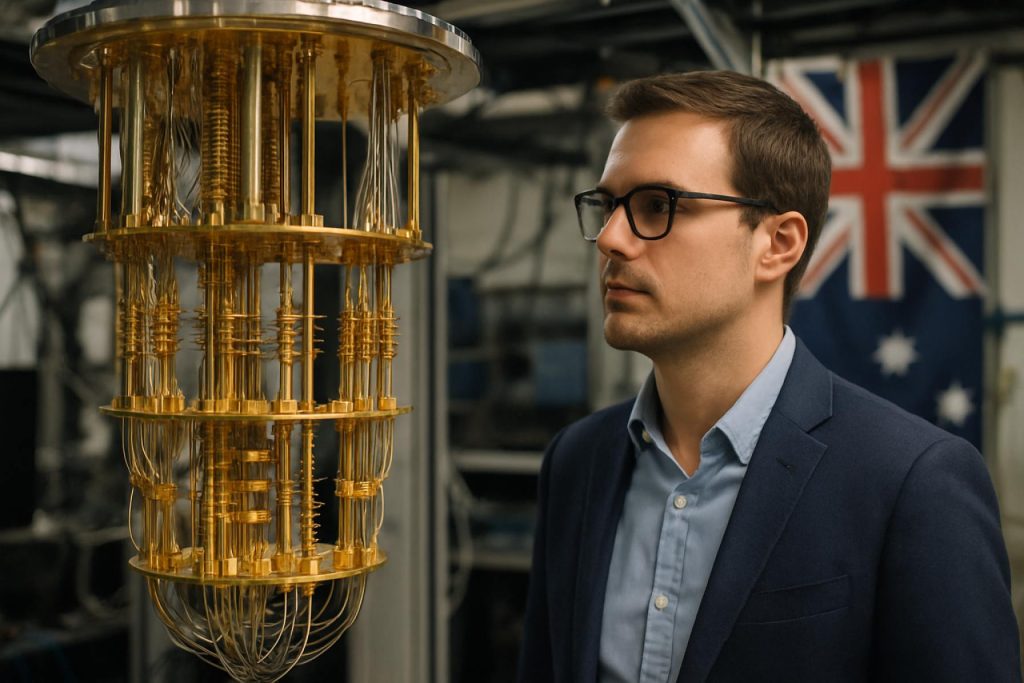
- Australia stands at the forefront of global quantum technology innovation, leveraging decades of scientific expertise to power new industries.
- Quantum computing promises breakthroughs for traffic management, renewable energy, agriculture, and artificial intelligence—moving from theory to practical impact.
- The National Quantum Strategy and CSIRO’s quantum roadmap highlight the need for collaboration between government, industry, and academia to build a quantum-ready workforce.
- Australian ventures pursue diverse quantum approaches, such as photonic qubits, superconducting circuits, and ion traps, showcasing local talent and leadership.
- Quantum advances in cybersecurity, secure communications, and sensing are already delivering tangible benefits, from ultra-secure networks to advanced medical diagnostics and resource exploration.
- The choices Australia makes now will determine its future as a global leader in the quantum age.
A wave of innovation surges across Australia, powered by the strange and beautiful rules of quantum physics. From quiet university labs to bustling research consortia, the nation has quietly amassed a deep reservoir of quantum expertise—now poised for transformation into a world-class industry. The stakes feel historic: as the global chase for quantum supremacy accelerates, Australia stands at a crossroads, its fate tied to decisions made today.
Picture a future where computing power leaps light-years ahead—solving traffic snarls across a sprawling city, optimizing renewable energy grids, or even designing drought-resistant crops tailored for a changing climate. This isn’t a scene from science fiction. As quantum technologies emerge from abstract theory into practical reality, Australia has become a force to be reckoned with, drawing on almost a century of relentless inquiry that began when quantum mechanics itself revolutionized our perception of matter.
With global investment scaling new heights and governments worldwide declaring quantum capability a matter of national priority, Australia outlined its ambitions through bold initiatives such as its national science agency’s quantum roadmap and the 2023 National Quantum Strategy. These blueprints shine a spotlight on the need for focused collaboration—uniting government, researchers, and forward-thinking entrepreneurs to cultivate a new breed of scientists, engineers, and business leaders.
It’s a formidable challenge. Transforming quantum science into tangible results requires more than brilliant minds: a robust workforce, cutting-edge infrastructure, strategic investment, and fertile ground for public-private ventures. Already, fragments of the future are visible. Australian-backed ventures like PsiQuantum harness photonic qubits, while others explore superconducting circuits or the elegant atomic choreography of ion traps—a global pursuit, yet one where local talent shines.
Yet tech alone is only half the equation. The unpredictable, fragile nature of quantum systems—plagued by what physicists call “noise”—demands new protocols, hardware, and quantum-tuned software. Researchers are racing to craft algorithms that thrive amid quantum chaos, unlocking breakthroughs in materials science, artificial intelligence, and beyond.
Then comes security. The very same quantum computers that could shatter contemporary encryption protocols also promise next-gen communication channels—utterly secure, immune to eavesdropping, and instantly alerting users at the faintest sign of intrusion. CSIRO researchers probe free-space quantum link-ups, eyeing a day when Earth-to-satellite connections stay one step ahead of global threats. Even geo-location could be transformed, ensuring navigation in an era when GPS systems are more vulnerable than ever.
Some quantum advances are already tangible. The unique sensitivity of quantum sensors unlocks new vistas, from mapping hidden mineral wealth far beneath Australia’s red earth to portable devices that reveal iron levels in a drop of blood—breakthroughs arriving not in a distant future, but now.
As the United Nations gears up for the International Year of Quantum Science and Technology in 2025, momentum builds. Australia’s quantum pioneers help usher in an era of unprecedented possibility, with far-reaching impacts for healthcare, security, industry, and the environment.
The key message is clear: Australia’s choices today will shape its destiny in a field set to transform the world’s technological landscape. The race is on. If vision turns into action, the nation could emerge not only as a leading player but as a genuine architect of the quantum age—one computation, one discovery at a time.
Quantum Australia: How the Quantum Revolution Down Under Could Change Everything (and Sooner Than You Think!)
Australia’s Quantum Leap: Unseen Facts, How-Tos, Market Trends, and What’s Next
Australia’s quantum ambitions are capturing global attention, with major initiatives like the National Quantum Strategy and the national science agency’s quantum roadmap. But there’s an untold wealth of detail and opportunity bubbling beneath the headlines. Here’s a deep dive into the lesser-known facts, real-world applications, and practical insights that will shape the nation’s quantum destiny—and what you can do to get ahead.
—
Untapped Quantum Facts & Industry Trends
1. Australia’s Research Pedigree and Historic Firsts
– Australia is home to the world-renowned Centre for Quantum Computation and Communication Technology (CQC2T), founded at UNSW Sydney, which has been a pioneer in silicon-based quantum computing since the late 1990s.
– The first-ever demonstration of a quantum logic gate in silicon occurred in Australia (Nature, 2015), solidifying the nation’s status at the leading edge of hardware innovation.
2. Commercial Quantum Startups Surging
– Beyond PsiQuantum, Australian startups like Silicon Quantum Computing (SQC) and Quantum Brilliance are forging new paths: SQC pursues atomic-precision manufacturing, while Quantum Brilliance develops room-temperature, diamond-based quantum accelerators.
– Many startups have attracted multimillion-dollar investments from both domestic and international venture capital.
3. Funding and Collaborative Ecosystems
– Australia’s government dedicated over $100 million to quantum technology development in the last five years, complemented by state initiatives and industry partnerships.
– Major universities contribute hundreds of postdoctoral and PhD quantum scientists, feeding a growing talent pool.
4. Global Quantum Market Projections
– The global quantum computing market is forecasted to reach $4.4 billion by 2028 (MarketsandMarkets), and Australia’s share could be worth $2.5 billion annually within a decade, assuming strategic investment and successful scale-up.
—
Real-World Use Cases: From Theory to Tools
1. Mining & Exploration
– Quantum sensors are already revealing remote, buried mineral deposits faster and at lower cost, giving Australia an edge in global resource exploration [Source: CSIRO].
2. Drug Discovery and Healthcare
– Quantum simulation could reduce drug development times from years to months, optimizing molecular structures beyond the reach of classical computers.
3. Supply Chains & Smart Cities
– Quantum optimization models are being trialed to minimize traffic congestion, lower logistics costs, and improve urban liveability in pilot smart-city projects across Sydney and Melbourne.
—
Reviews & Comparisons: Where Does Australia Stand?
| Country | Focus Area | Strengths | Limitations |
|———————-|—————————-|———————————–|———————————-|
| Australia | Silicon qubits, photonics | Strong R&D, gov’t support | Talent shortage, scaling |
| USA | Superconducting qubits | Private investment, large market | Regulatory uncertainty |
| China | Photonic, ion trap | Government funding | IP transparency, export limits |
| EU (Germany, UK) | Trapped ions, topological | Academic excellence | Fragmented initiatives |
—
Pressing Reader Questions—Answered
Is quantum computing truly close to real-world deployment?
Australia’s silicon and diamond-based qubit prototypes now operate at “logical” fidelity levels approaching the threshold for useful error correction, with room-scale quantum accelerators already being field-tested for industrial tasks at Quantum Brilliance labs.
How secure are quantum communications?
Quantum Key Distribution (QKD) trials in Australia use entangled photons for communication links that are mathematically proven to flag any interception attempts, making them vastly more secure than classical encryption (see research from CSIRO).
Can quantum computing threaten existing encryption?
Yes, quantum algorithms like Shor’s algorithm could break widely-used encryption (RSA, ECC) within years of fault-tolerant quantum computers’ arrival. Governments and banks are already funding quantum-resistant cryptography research.
—
How-To: Preparing for the Quantum Economy
1. Upskill Now:
Take short courses in quantum basics through edX, Coursera, or university-led online programs (UNSW, UQ, Melbourne). Quantum literacy is a differentiator for tomorrow’s jobs.
2. Tap Innovation Hubs:
Engage with local quantum-centred innovation hubs (like Sydney Quantum Academy) for mentorship, funding, and career opportunities.
3. Adopt a Quantum Security Mindset:
If your organization handles sensitive data, start a review of your cryptographic protocols and investigate quantum-safe alternatives.
—
Controversies & Limitations
– “Quantum Hype” vs. Reality: Some critics warn about overpromising timelines for quantum advantage. True large-scale, fault-tolerant quantum computers may be at least 5–10 years away (source: McKinsey 2023).
– Workforce Shortage: While Australia produces top quantum talent, it faces intense global competition and risks a “brain drain” if investment stalls.
– High Infrastructure Costs: Building and maintaining cryogenic and vacuum systems for quantum hardware is energy-intensive—raising sustainability questions.
—
Pros & Cons Overview
Pros:
– World-class research ecosystem
– Government investment and strategic vision
– Unique real-world testbed (e.g., mining, healthcare)
Cons:
– Talent and infrastructure bottlenecks
– Uncertain timelines for commercial quantum advantage
– High R&D costs, potential export barriers
—
Security & Sustainability Insights
Quantum tech could enhance cybersecurity and enable complex climate modeling—but energy consumption and rare material usage in quantum hardware production are challenges. Efforts are underway (e.g., Quantum Brilliance’s room-temperature devices) to develop greener, less resource-intensive systems.
—
Actionable Recommendations
– For Businesses: Explore quantum-readiness audits with Australian quantum consultancies. Get ahead of disruption and find first-mover advantages.
– For Policymakers: Prioritize workforce development, STEM education, and support for local entrepreneurship.
– For Students & Job Seekers: Enroll in quantum computing bootcamps and participate in hackathons to build in-demand skills.
—
Quick Tips to Apply Now
– Set a Google Alert for “quantum Australia” to stay updated on research and industry news.
– Follow leading Australian quantum figures on LinkedIn and Twitter for early insights and networking.
– Attend quantum technology webinars or public lectures in your region—many are free and beginner-friendly.
—
Conclusion:
Australia’s quantum future is at a tipping point. By leveraging world-class expertise, robust policy frameworks, and a collaborative innovation culture, the nation is uniquely positioned to lead the global quantum race. From cybersecurity to environmental resilience, practical real-world benefits are on the horizon—but only if today’s stakeholders invest, learn, and adapt. Stay curious, stay connected, and be quantum-ready.
_For more updates on quantum innovation and science news, visit the official site of Australia’s national science agency at CSIRO._



